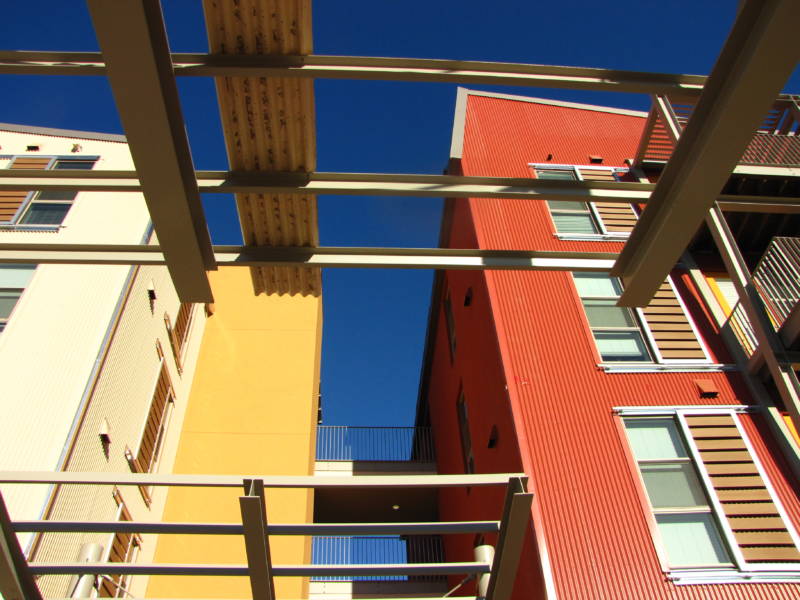Davis housing development claims to the the nation’s biggest

The typical American master-planned community sill features cookie-cutter houses, cement driveways and green lawns. But UC Davis is putting a new spin on the concept with the unveiling of West Village, a $300 million student and faculty housing community designed to be “zero-net energy.” Developers say it’s the nation’s largest to employ this kind of green construction.
And although “zero-net” [PDF] may sound complicated, the concept is actually quite simple: All the buildings in West Village will take in as much energy as they put back into the power grid — not on a daily basis but at the end of each year, the total consumption of the entire housing development should “net out” to zero.
The modern, colorful development taps into a four-megawatt photovoltaic system driven by 15,000 solar panels. The panels are mounted on rooftops, parking canopies, sides of buildings and even the village clock tower.
“It’s a sizable amount of solar,” Bob Segar, UC Davis director of campus planning told me on a recent walking tour (slide show below). Roughly 3,000 students and faculty in 662 apartments and 332 single-family homes will call the West Village home once it’s fully completed in 2013. For now, 800 students and faculty live in two residential halls.
But the development’s energy efficiency goes beyond solar panels. Segar said the entire complex was strategically built on 200 acres of university land to reduce residents’ need to tap into solar in the first place.
For example, mixed-use residential halls featuring retail space are situated along streets that run east-west in order to maximize the “solar gain” or breeze on any given day. All the buildings are equipped with energy efficient appliances, as well as customized window awnings with moveable wooden slats that allow residents to control the amount of sun that enters their rooms. And a smart phone app lets residents turn off lamps and plugged-in electronics remotely.
“First you reduce the energy demand through the layout of the community and investing in energy efficiency,” said Segar. “And then you produce green power on site.”
Another way West Village plans to produce its own green power is with a waste-to-energy bio-digester – an invention patented by UC Davis engineer that will be in full use next year. It will convert the village’s garbage and waste, also referred to as “feed stock,” into energy.
“The technology will allow us to put all those ‘feed stocks’ into the bio-digester, which will decompose at different rates that will then make methane and hydrogen to be burned for electricity,” Segar said.
The bio-digester underscores the influence UC Davis researchers have had on the overall development of West Village. Campus planners relied heavily on faculty from several engineering departments to make this development among the most energy-efficient in the nation.
The project is a collaboration between UC Davis and West Village Community Partnership, LLC (a joint venture of Carmel Partners of San Francisco, and Urban Villages of Denver. The developer has a 65-year lease with the university.
Other West Village features include:
- Sacramento City College’s Davis Center at UC Davis West Village, the first community college center to be housed on a University of California campus. The center will open to an estimated 2,400 students in January.
- UC Davis’ first “uHub,” a prototype for future campus innovation hubs and an incubator for innovation in sustainability. Located in commercial space surrounding the village square, the uHub will be home to the campus’s energy research centers, serving as a living laboratory and fostering interactions with the private sector in the area of energy research.
- A recreation center featuring a game room, gym, pool and study areas.
- Energy-efficient exterior lighting fixtures, indoor occupancy sensors and “daylighting” techniques, to help the community use about 60% less energy than if standard lighting had been used.

